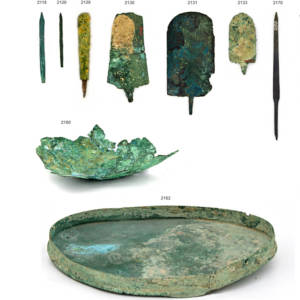Using AI to control energy for indoor agriculture
30 September 2024
Published online 16 August 2018
Isotope analyses of ancient Egyptian copper artefacts reveal mainly local metal sources and early trade links.

Journal of Archeological Science, © Elsevier, 2018
The scientists applied chemical characterisation techniques and lead isotope analyses to copper artefacts from ancient Egyptian burial sites (ca. 4400–2130 BCE) that were housed in museums in Germany and Belgium. The methods involve linking chemical and isotopic ‘fingerprints’ in the artefacts with those of copper ores in potential mining sites in the region.
Inscriptions carved on rocks and archaeological sites around known sources of copper ore led archaeologists to theorize that ancient Egyptians obtained the copper they used to make items such as vessels, utensils, and weapons from the Sinai Peninsula and the Eastern Desert, or from as far away as Israel, Jordan, the Arabian Peninsula, and Anatolia. Without scientific analyses, however, they had no way of pinpointing Egypt’s sources of copper and changes in their exploitation over time.
While the discovery that early Egyptian copper came from local sources is not a surprise to the researchers, “it is a very important step in the scientific process to validate this analytically, as it allows us to deepen our understanding of how metallurgical technology evolved in Egypt,” says archaeological scientist Frederik Rademakers from Belgium’s Katholieke Universiteit Leuven.
The studies found that mining practices changed over time.
Copper from items in the tomb of King Khasekhemwy, who ruled during the Early Dynastic Period and was buried in Abydos, about 170 kilometres north of Luxor, came from many sources in the Eastern Desert and the Sinai, for example. Copper artefacts from the later Old Kingdom tombs at Giza in northern Egypt were made only from Eastern Desert ores.
Lead isotope analyses of a copper vessel found in a First Dynasty (ca. 3000–2890 BCE) tomb from Abusir, just south of Giza, indicate that the vessel was similar to material in Anatolia. This is the earliest evidence of Anatolian–Egyptian copper trade that can be accurately dated.
Ancient Egyptians may have desired the Anatolian metal because its combination of copper, arsenic and nickel gave it a unique [more whitish] colour, explains Egyptologist Martin Odler of Charles University in the Czech Republic. He expects the metal was part of the interregional trade in the late 4th and early 3rd millennia BCE.2
Both studies examined copper artefacts housed in European museums due to difficulties in accessing archaeological samples in Egypt. Rademakers recognizes that his study’s findings might not reflect the full spectrum of copper objects in use in Ancient Egypt.
This research is part of a bigger movement to understand the often-neglected subject of ancient metal working, says Nils Anfinset of Norway’s University of Bergen, who was not involved in the two studies. “The findings from these papers suggest that the Egyptians used a wide range of sources, painting a much more varied picture than was previously thought,” he says. The studies improve our understanding of how Egyptian civilization developed, he adds.
doi:10.1038/nmiddleeast.2018.93
Stay connected: